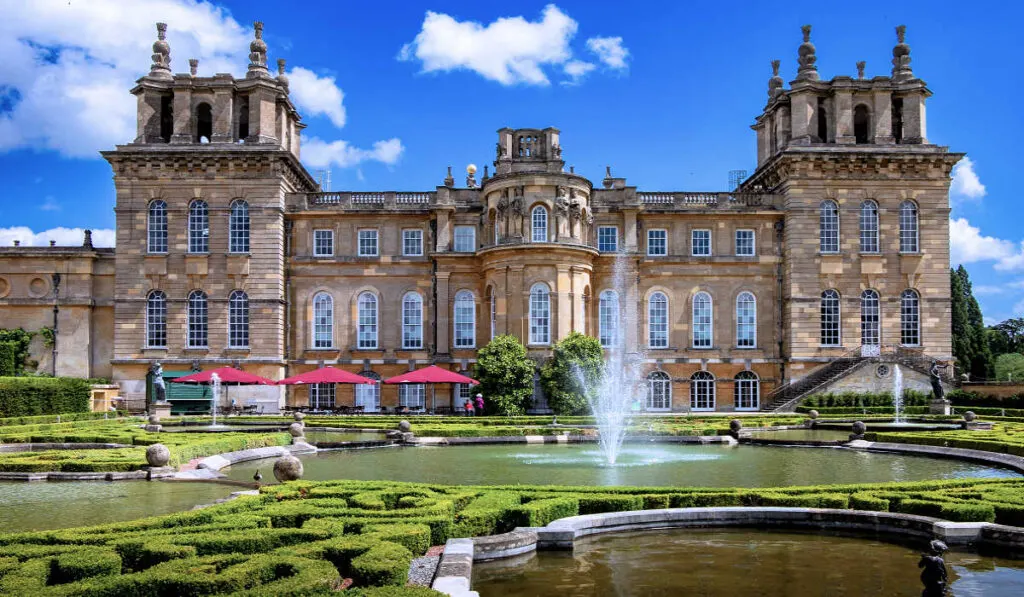
The United Kingdom has a rich history, and its royal family has reigned over the land for more than 35 generations. While England is small, there’s no shortage of amazing castles to visit and historic royal palaces to admire. Many of England’s palaces are restored to perfection, and most belong to the Royal family.
These sovereign residences have hosted royal weddings and births, and some carry dark tales of torture and imprisonment throughout the years. While each is unique, visiting these historic structures showcases unique architecture, opulent interiors, priceless artworks, and manicured gardens.
The mere fact that nobility lives in residence doesn’t make it a palace. A palace is an ornate or opulent building built for Royalty, head of state, or high-ranking officials. Lambeth Palace, the Archbishop of Canterbury’s home, is an excellent example.
What To Know Before You Go
- While many palaces are open to the public year-round, some have limited access. For example, Buckingham Palace opens its doors to visitors only a few months of the year. Make a reservation early as tickets sell out months in advance. So, check the opening schedules online so you won’t be disappointed.
- Bear in mind that some palaces are lived in, so an entry ticket may only include a few rooms or a section of the residence. Check to see what’s included in the purchase price. I once paid a hefty fee to see a castle, only to leave disappointed because I saw only four staterooms. The cost was mostly for visiting the grounds.
- Medieval structures require constant maintenance and restoration. Don’t be surprised to arrive and see some scaffolding. Inside, individual rooms may be closed if repair is in progress.
- Medieval palaces are old and do not contain the modern amenities we come to expect today. While a few have installed elevators, most are not wheelchair accessible. Even some places like Apethorpe Palace lack modern bathrooms for public use.
- Some palaces charge a high entrance fee, although sometimes, the pass is good for twelve months. Even if the ticket isn’t open-ended, know that your money helps towards expensive maintenance so that our descendants can continue to enjoy these venues.
- Photography may not be permitted during your visit. Should it be allowed, in most cases, it must be without the use of a flash.
- Some venues are large and require an entire day to see all it has to offer. Research how long it takes to visit. You don’t want to arrive at 2 pm and miss half the palace.
- Not all royal palaces are on a transit route. Some may require a bus tour or rental car to get there.
Buckingham Palace
- Location: Westminster, London SW1A 1AA | Nearest Tube Station: St. James Park or Green Park
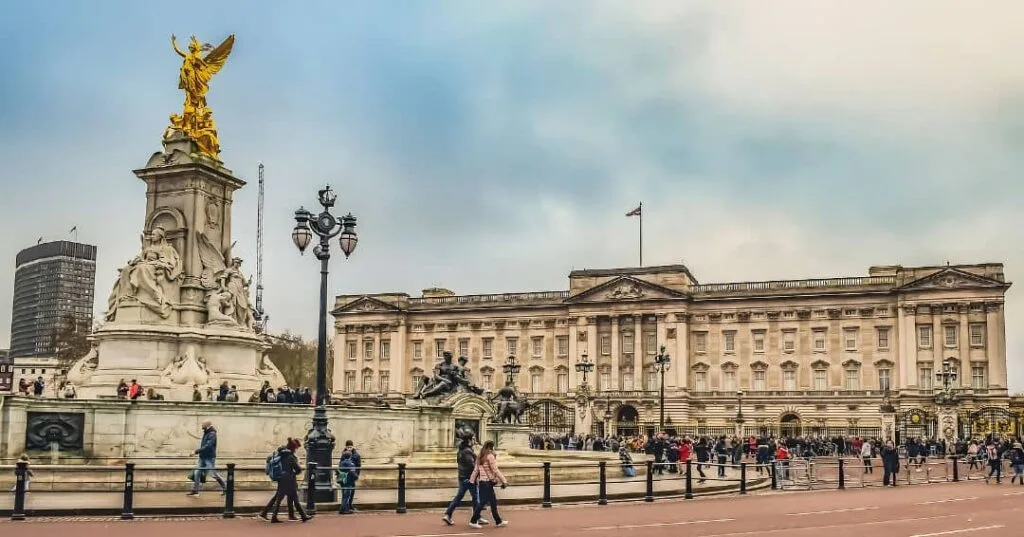
Buckingham Palace is the most famous of all Palaces in Britain. It has served as the Royal family’s London residence for over 180 years. The palace contains 775 rooms, 52 of which are Royal and guest bedrooms and 188 staff bedrooms.
If you visit, look for the Union Jack flag flying high on the flag pole. If you see it, the Queen is currently home during your visit. Buckingham palace was only viewable from the outside during its history as a Royal residence.
In 1993, Queen Elizabeth II opened the Palace for limited weeks in the summer months to pay for Windsor Castle’s expensive restoration after a fire. Since then, Buckingham Palace has remained open to tourists for ten weeks in the summer and selected dates in the winter and spring.
Visitors to the palace view 19 exquisite State Rooms. The family uses these rooms to entertain guests and host official functions throughout the year. Don’t make the mistake of not booking ahead to see this magnificent structure.
Buckingham Palace’s balcony is one of the most famous in the world. It serves as a gathering point on special occasions. The first recorded Royal balcony appearance occurred in 1851 when Queen Victoria stepped onto it.
Since then, Prince William and his wife Kate Middleton shared a kiss on the balcony shortly after their wedding, as did Prince Harry and Meagan Markle.
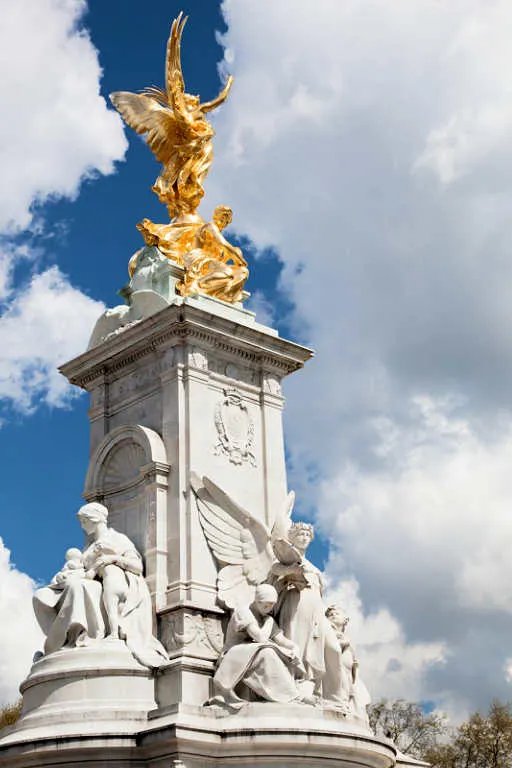
No trip to the palace is complete without seeing the famous “changing of the guard.” The Queen’s Guard dress in traditional red tunics with bearskin hats. It’s free to watch the ceremony and takes place at 10:45 am on Mondays, Wednesdays, Fridays, and Sundays, weather permitting. The event gathers a crowd, so get there early to secure the right viewing spot.
The Royal Mews is the royal stables on Buckingham Palace’s grounds near Grosvenor Place. Undoubtedly the finest stable globally, the Mews houses approximately 30 horses, stately carriages, and historic coaches used by the royal family.
The most iconic and glaring is the Gold Stage Coach used during the Golden Jubilee celebrations in 2002. George III commissioned the Gold Stage Coach in 1760.
While visitors to London stop at Buckingham Palace, most are unaware that the Royal Stables are open to the public. So, stop by if you’re looking to escape the crowds. The Royal Mews is a London hidden gem worth discovering.
Kensington Palace
- Location: Kensington, London W8 4PX | Nearest Tube Station: High Street Kensington or Queensway
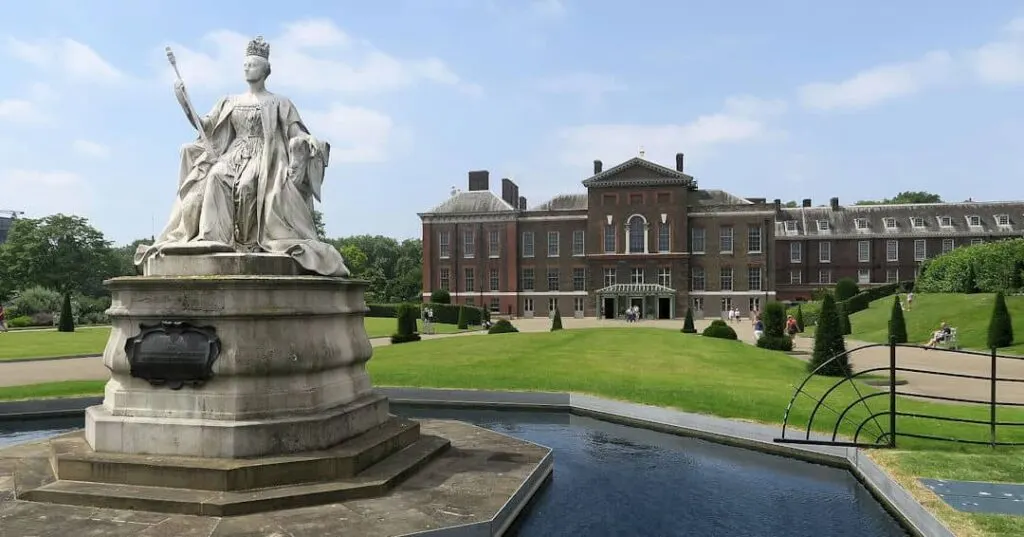
Set within the Kensington gardens, Kensington Palace has served the Royal family as a residence since the 17th century. Once called Nottingham House, the structure underwent an enlargement in the late 1600s, transforming it into the palace seen today.
It is currently the official London residence of the Duke and Duchess of Gloucester, the Duke and Duchess of Kent, and Prince and Princess Michael of Kent.
Notable Royalty to live at the Palace included Queen Victoria, born there, and Princess Diana, who had an apartment from 1981 to 1997. Prince William and Prince Harry also made this palace their childhood home.
Since much of the home is a royal residence and in use, it is closed to the public. However, visitors can tour the King’s State Apartments, Queen’s State Apartments, King’s Gallery, the featured exhibition, and portions of the grounds.
Lambeth Palace
- South Bank, London SE1 7JU | Nearest Tube Station: Westminster
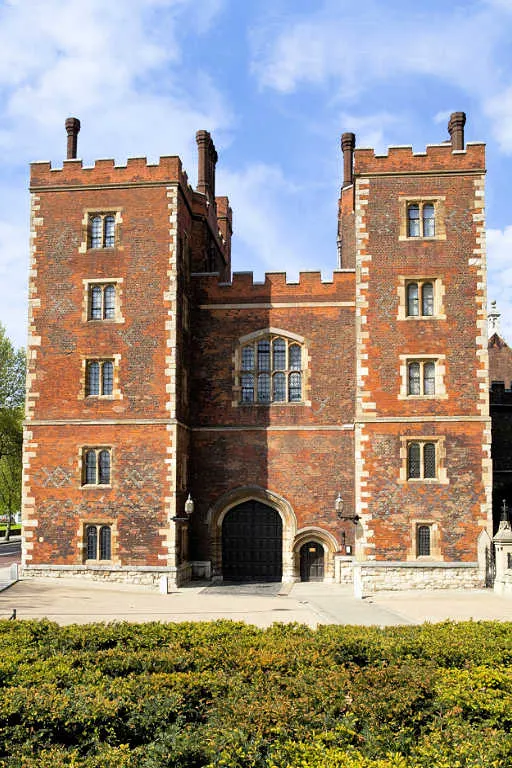
The Archbishop of Canterbury’s official home is Lambeth Palace. It is located on the south bank of the River Thames in London, 400 yards from the Parliament building. The front of the Palace features a brick-faced, 500-year-old Tudor gatehouse resembling Hampton Court’s gatehouse.
Tucked away in the heart of the city, the Palace is easily missing by most tourists as it does not stand out amongst the other iconic attractions in London.
Within the grounds of the Palace, the Palace Library contains over 120,000 religious’ books, some dating back to the 12-century. Notably, this is the largest sacred collection outside of the Vatican.
Since the residence is a working Palace and private home, it is not generally open to the public. However, there are special occasions where tourists can view the palace with guides.
The tour includes rooms and Lambeth Palaces’ chapels while learning the history of the previous Archbishops of Canterbury. Visitors can enjoy the historic grounds during the summer, which are said to be one of the oldest London gardens.
Hampton Court
- Location: Hampton Ct Way, Molesey, East Molesey KT8 9AU | Nearest Railway Station: Hampton Court

Are you looking for a day trip outside of London? Then, consider visiting Hampton Court Palace, a Royal residence in Richmond Upon Thames, 12 miles outside London. Cardinal Thomas Wolsey began the Palace in the early 16th century.
Hampton Court became King Henry VIII’s favorite place, bringing all his six wives there. The Palace underwent many restorations, some destroying the Tudor features and favoring the Baroque style.
In 1838, Queen Victoria opened the Palace to the public for the first time. In less than 50 years, Hampton Palace recorded over 10 million visitors worldwide.
As you approach Hampton Court, its grand Tudor exterior stands out. Some say the Palace is haunted; by not one but two of King Henry VIII’s wives. Jane Seymour (3rd wife) died there in childbirth in 1537, and Catherine Howard (5th wife) was executed in 1542.
Visitors enjoy a unique astronomical clock made in 1540 for King Henry VIII in the courtyard. Not only does it tell the date, but also the signs of the zodiac and the sun’s position.
Inside the palace, the Great Hall is mesmerizing with its hammerbeam ceiling. Over 100 feet long, this grand space with extensive wall tapestries hosted ceremonies, balls, and social gatherings.
Like many palaces and castles, Hampton Court has a hedge maze covering one-third of an acre. Planted between 1689 and 1695, it’s renowned for being Britain’s oldest surviving hedge maze. If you plan to try it, plan to spend 20 minutes walking half a mile of maze pathways.
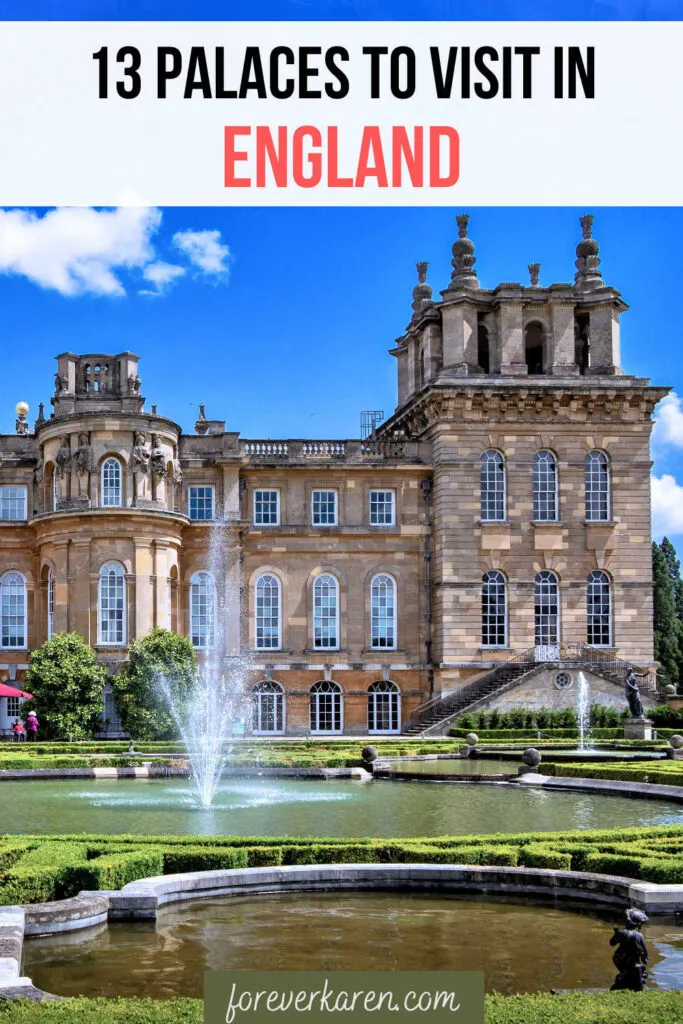
Movie makers have featured Hampton Court in “A man for all seasons” (1966), “The Pirates of the Caribbean: On stranger tides” (2011), “Sherlock Holmes: A game of shadows” (2011), and Disney’s “Cinderella” (2015).
Eltham Palace
- Location: Court Yard, London, SE9 5QE | Nearest Railway Station: Mottingham or Eltham
Eltham Palace is a fine example of a Medieval palace and was extensively used by the Tudors. The most notable of them, Henry VIII, spent much of his childhood at Eltham. For a couple of centuries afterward, the palace was left to decline.
In the 1930s, millionaires Stephen and Virginia Courtauld purchased the estate. They spent money on repairs and added a unique Art Deco house which contrasts significantly with the original architecture.
The initial palace was constructed on a butterfly plan with two wings. The Great Hall, which has a magnificent oak beam ceiling, joins both wings. After the Courtaulds acquired the home, they restored the Great Hall to its former glory. Being avid gardens, they designed some of the outer areas too.
Today, the English Heritage maintains the estate. Unlike most palaces which stay true to their medieval design, visitors to Eltham will see a mix of old and new. Outside, the grounds have a mix of traditional cultured landscapes and a modern, organic rock garden.
Blenheim Palace
- Location: Woodstock, Oxfordshire, OX20 1UL | Nearest Railway Station: Combe or Hanborough
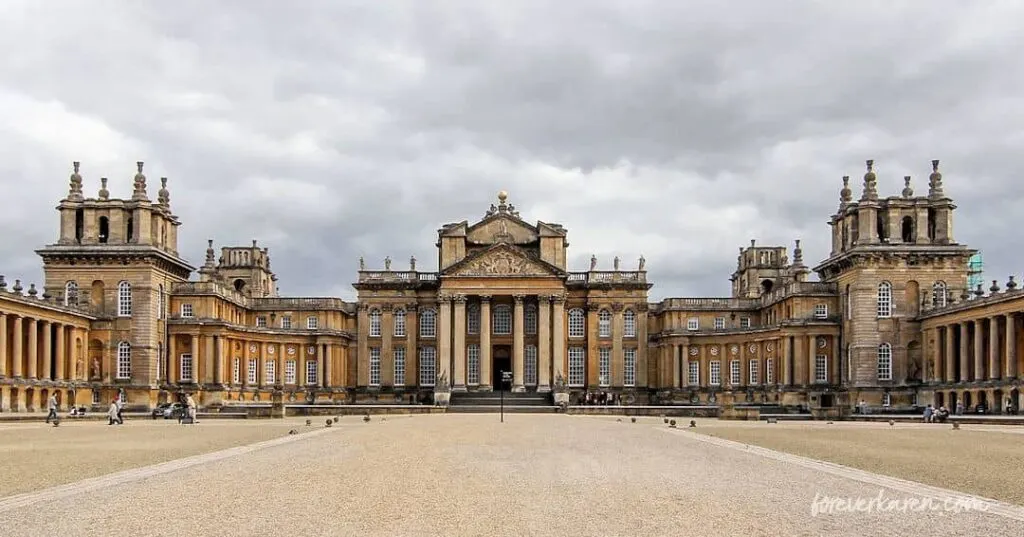
Located in Woodstock, Oxfordshire, Blenheim Palace is Sir Winston Churchill’s birthplace. It’s one of the most inspiring Palaces in Britain, yet it is not a Royal residence. It is the Dukes of Marlborough’s principal residence and the only non-royal, non-episcopal home in Britain to carry the title of “Palace.”
This beautiful property sits on 2,000 acres of pristine landscape with stunning formal gardens. If you can only manage to visit one British Palace, consider a day trip here by train from London.
During World War I, the Baroque Palace served as a convalescence hospital for injured soldiers. During the Second World War (1939 to 1940), the military evacuated more than 400 boys to the Palace from Malvern College.
In 1950, the Palace opened its doors to the public for the first time, and in 1987, it became a UNESCO World Heritage Site. The gardens of Blenheim Palace are pristine, with manicured hedges and stunning water features, emulating those of Versailles’ famed gardens.
On the grounds, the Diana Temple marks the spot where Winston Churchill proposed to his future wife, Clementine Hozier.
In 2018, to preserve the historic Vanburgh Bridge, the lake surrounding the bridge was drained to remove silt built up at its footings. After draining the water, Archaeologists found sunken boats, secret tunnels, and graffiti dating back to 1756.
Inside the palace, the staterooms are stunning, especially the Long Library with its buttercup walls and dome ceilings. In the Saloon, the trompe-l’oeil ceiling is a stunning masterpiece by French artist Louis Laguerre.
Blenheim Palace hedge maze features a staggering 3,000 yews. Covering 1.8 acres, the Marlborough Hedge Maze is the second-largest in the world. It contains two bridges that help the adventurous mazers find their way out.
St. James Palace
- Location: Marlborough Rd, St. James’s, London SW1A 1BQ | Nearest Tube Station: Green Park

While St. James Palace is no longer the primary Royal London residence, it has housed many Kings and Queens throughout its history. Built by King Henry VIII, the original red brick building still stands as it did hundreds of years ago.
Located in the heart of Westminster, St. James Palace is the Queen’s oldest residence. Notable Royal members who lived there (as of Jan 2021) include Prince Charles, the Duchess of Cornwall, and Princess Alexandra.
St. James Palace hosts numerous official functions throughout the year, including state visits and charity events. The Windsor family reserves the rooms on the upper floor, while the lower floor staterooms contain offices. It is here that the Accession Council upon the death of every British monarch.
The Royal Chapel on the grounds hosted milestone events such as the christening of Prince George and Meagan Markle’s baptism shortly before her marriage to Prince Harry.
Although St. James Palace is not open to the public, visitors can view this beautiful Tudor structure from the outside and attend a chapel service.
Royal Pavilion
- Location: 4/5 Pavilion Buildings Pavilion Gardens, Brighton BN1 1EE | Nearest Railway Station: Brighton
Located in Brighton, south of London, the Royal Pavilion looks out of place in England with its Indo-Gothic onion domes. The small seaside building was a vacation home for Princess George, who later became King George IV. Enlarged and transformed in stages, it grew into the magnificent mansion seen today.
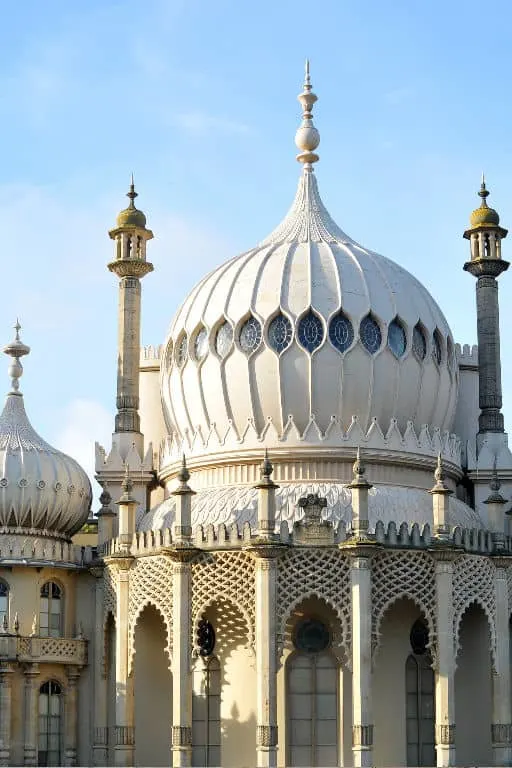
Formerly called the Marine Pavilion, its quirky look is the brainchild of John Nash, with an Indian-style exterior and a Chinese influence interior. The inside of the building is as spectacular as the outside, with jaw-dropping details everywhere.
Some stand-outs are the Banqueting Hall, Long Gallery, and Kitchen. In the Banqueting Hall, the stunning chandelier held by the claws of a silver dragon impressed me. Above it, the bamboo leaves ceiling décor is breathtaking.
State-of-the-art technology such as steam heating, a ventilation system, and a constant fresh water supply were modern additions for its time in the Great Kitchen. Like many other rooms in the palace, it has fashioned bamboo posts with exotic plantain foliage.
Queen Victoria disliked the estate due to its lack of privacy and insufficient size for her growing family. So, Brighton purchased the Royal Pavilion, which resulted in its beginning as a tourist attraction. In the mid-1800s, Brighton converted the stables into Brighton’s concert hall, also called the Brighton Dome.
During my visit, the palace did not allow me to take photos indoors. Today, visitors can take pictures without the use of a flash.
Sandringham House
- Location: Sandringham, Norfolk, PE35 6EN | Nearest Railway Station: King’s Lynn
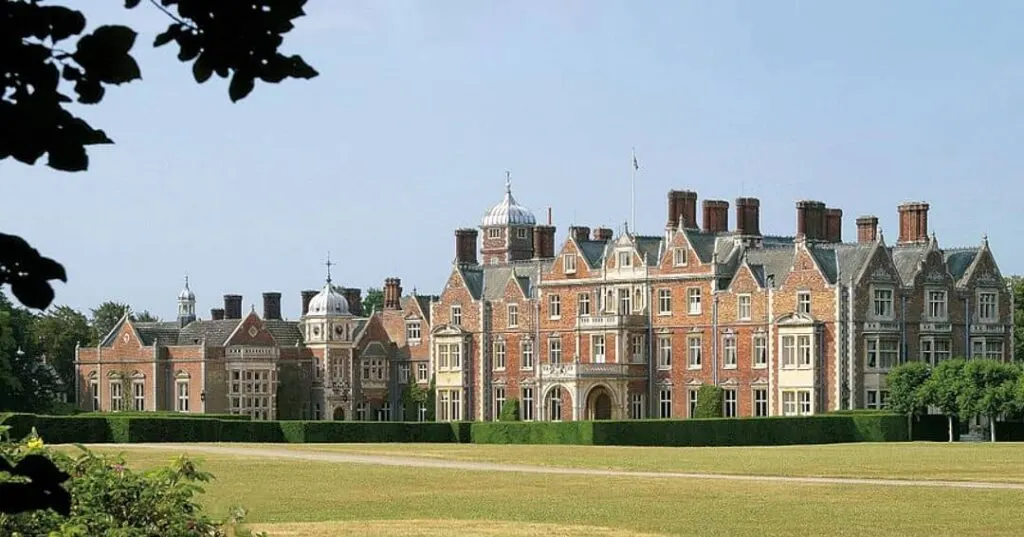
Located in Norfolk, Sandringham House is the royal family’s home away from home and where they gather for Christmas. In fact, the Queen has given some of her Christmas speeches at Sandringham.
Unlike most royal residences owned by the crown, Sandringham belongs to the Royal family. Purchased in 1862 for the Prince of Wales, who later became King Edward VII, numerous monarchs have enjoyed the home.
The estate is extensive, covering over 20,000 acres, and includes thirteen villages and numerous homes. Anmer Hall, two miles from Sandringham House, is the Duke and Duchess of Cambridge’s country residence, which they received as a wedding gift from Queen Elizabeth. Interestingly, Diana, Princess of Wales, was born on the estate at Park House.
Sandringham Estate is a working farm that employs 200 people to keep it running smoothly. It contains a sawmill to mill wood, orchards to make apple juice, and blackberries to produce the British drink, Ribena.
Since 1977, Sandringham House has been open to the public. Its opening months are April to early November, when the royal family is absent. A visit here includes some staterooms on the first floor, a museum and a visitors’ center, St. Mary Magdalene parish church, and extensive grounds.
The small museum is located in the former stables and coach houses and houses the first royal vehicle, a 1900 Daimler. Travelers can extend their visit by staying at the Park House Hotel on the grounds of Sandringham.
Interestingly enough, the Queen rents out property on the estate. So, if you want to live amongst royalty, here’s your chance (if your pocketbook allows.)
Apethorpe Palace
- Location: Hunting Way, Apethorpe, Peterborough PE8 5DJ | Nearest Railway Station: Peterborough of Corby
Formerly known as Apethorpe Hall, Apethorpe Palace was a favorite country estate for the Tudor and Stuart kings and queens. The most famous were Henry VIII and Elizabeth I.
Built of honey-colored stone, the estate is striking in its Jacobean style. Thought to be constructed in the late 1400s, the impressive home has entertained the aristocracy.
After many years of deterioration and mounting debt, the home was sold in 1904, ending its relationship with the royal family. It continued its path to disrepair and was subsequently sold again in the 1940s.
Later, the Catholic Church converted it to an approved school that continued to operate for over 30 years. Eventually, the British Heritage acquired the palace and spent eight million on restoration.
The work was difficult because the house had no running water, heat, or power. The society knew this project required a private investor to spend a further ten million to restore the palace to its former glory.
In 2014, the sale to Jean Christophe, Baron Pfetten, and his wife, Nadia, ensured the residence history. The sale agreement allows the home to be open to the public fifty days a year for eighty years.
Nadia is a conservation architect and, with her husband, had previous restoration experience when they rebuilt a 17th-century French villa.
After some restoration work, Apethorpe Palace welcomes visitors in July and August. Tickets are available online, and the tours take a couple of hours. Sadly, visitors cannot take photos inside or on the palace grounds.
It’s advisable to book early as the palace allows only 25 people at a time, for just those couple of months per year.
Kew Palace
- Location: Royal Botanic Gardens Kew, Richmond TW9 3AE | Nearest Railway Station: Green Park
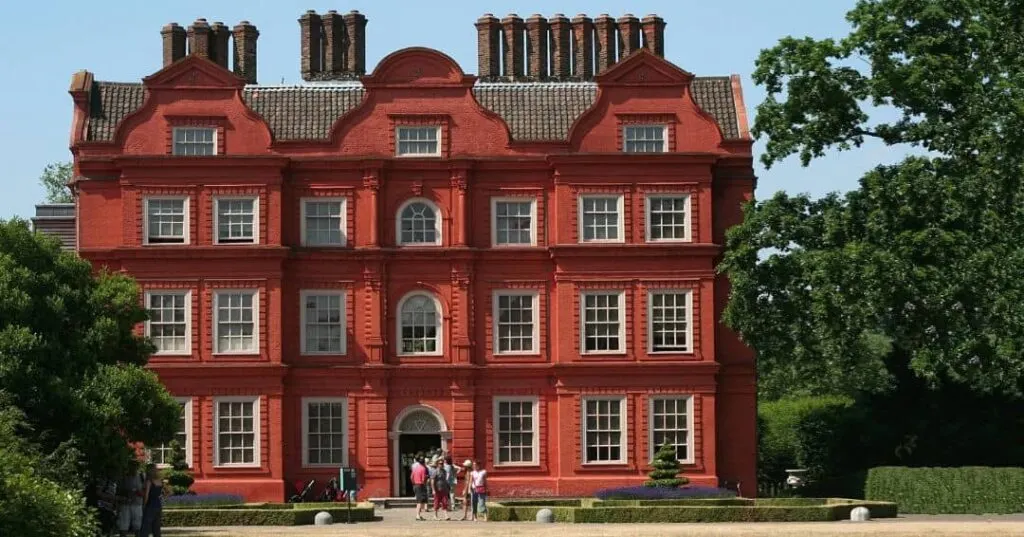
Located on the grounds of Kew Gardens, visitors often overlook Kew Palace. Constructed in 1631 for wealthy silk trader Samuel Fortrey, it’s the smallest of all royal palaces. It is one of three palaces that have occupied the land. The White House and the King’s Palace are the other two.
Approaching the Dutch country home, I thought the palace stood out like a sore thumb with its bright red brick façade. It’s far from palatial and resembles a comfortable, modest estate. In the late 1780s, George III’s increasing illness caused him to go mad.
His doctor sent him for seclusion at the palace, which served as a convalescing retreat. Queen Charlotte and her children enjoy the palace and a nearby retreat built in 1770 called Queen Charlotte’s Cottage.
After Queen Charlotte died in 1818, the home no longer served as a royal residence. Later, Queen Victoria opened the house for the public to enjoy. Inside, the small palace looks like a traditional home and lacks the ornate features of what we come to expect in a palace.
From the restored kitchen and sparse dining room to the Princesses’ bedrooms, you’ll get a glimpse into the lives of past Royalty.
Palace Of Westminster
- Location: Westminster, London, SW1A 0AA | Nearest Tube Station: Embankment
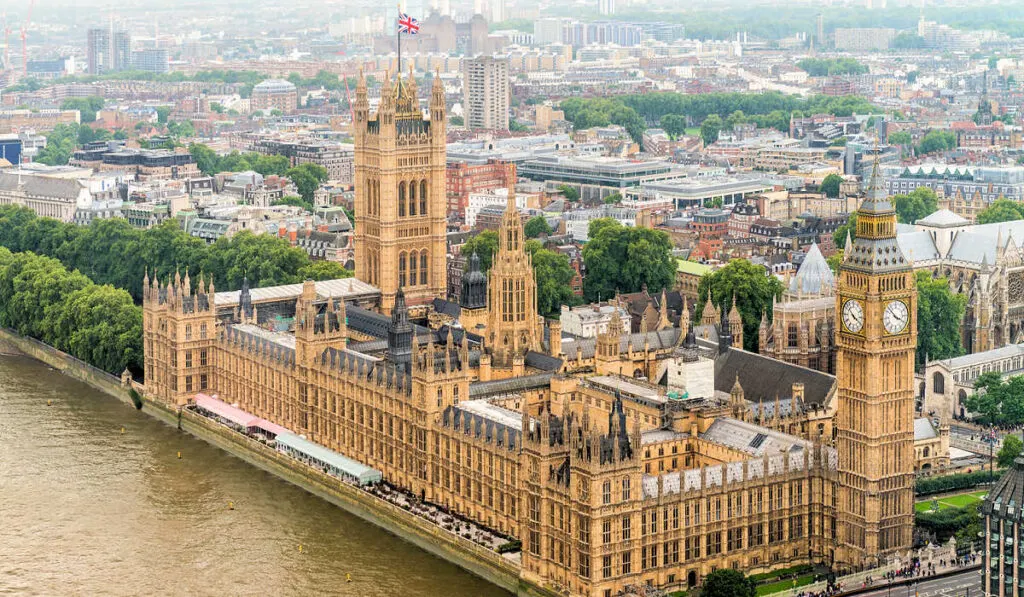
The Palace of Westminster is one of London’s most iconic landmarks, next to the River Thames. It is the seat of the House of Commons and the House of Lords, as well as Big Ben’s location. However, the impressive structure was built in 1042 and served as the primary residence for England’s kings.
In 1834, a massive fire destroyed much of the Palace of Westminster. It took more than a decade to agree on a design and rebuild a new palace. The new structure is vast and has over 1,100 rooms. You’d almost need a map to navigate its hallways.
Today, Westminster Hall is the oldest remaining element of the structure, built by King William II in 1097. Westminster Hall has functioned as a banquet hall for coronations and ceremonial Addresses to the Crown during the Queen’s Jubilees.
Book a guided tour of the Palace of Westminster to learn more about UK Parliament. The 90-minute tour includes the House of Lords, House of Commons, and Westminster Hall. If you can’t visit in person, you can book a complimentary ONLINE tour which lasts 45 minutes.
Banqueting House
- Location: Whitehall, London SW1A 2ER | Nearest Tube Station: Embankment or Westminster
Banqueting House is the only surviving section of Whitehall Palace, which suffered a devasting fire. White brick covers the structure’s exterior and looks unassuming. However, the interior shines with its magnificent painted ceiling, done by Flemish artist Peter Paul Rubens.
Throughout history, ceremonial events and state banquets were held at Banqueting House, or York Place as it was formerly known. But monarchs used it for healing ceremonies too. Centuries ago, people with skin ailments believed the touch of a monarch could cure them.
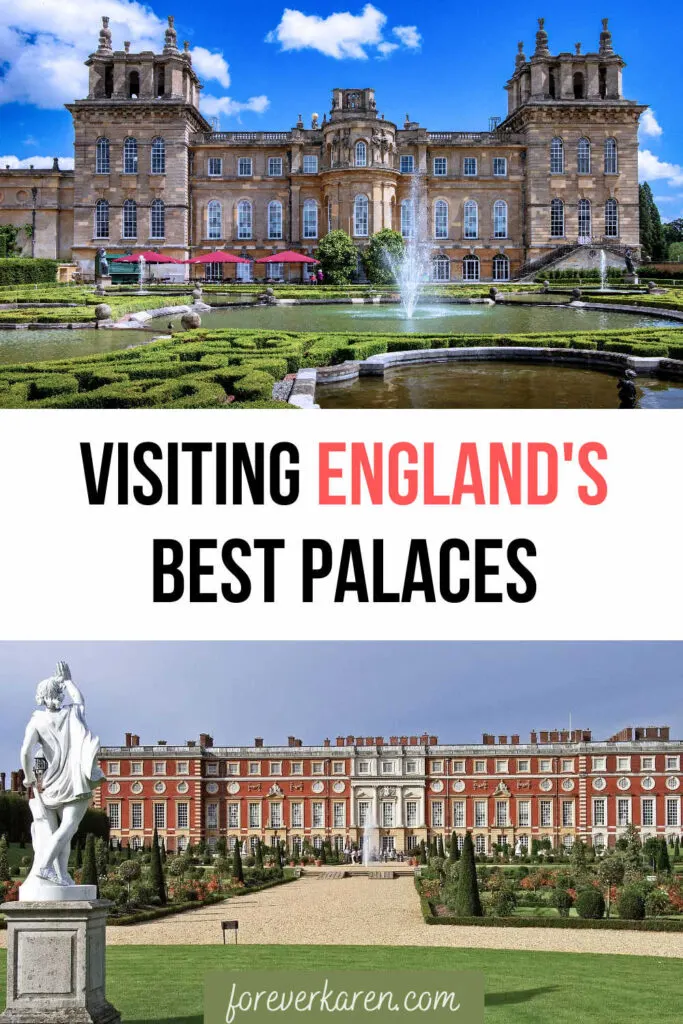
But the palace also holds a dark history. Kings Charles I was convicted of treason and beheaded outside the Banqueting House in 1649. After his death, his successor Charles II condemned those who ordered his execution. Every anniversary on January 30, the city holds a service in his honor at the Banqueting House.
Today, the Historic Royal Palaces manages the residence. However, due to ongoing construction, the building remains closed for visitation.
Other Palaces
England is a favorite place to visit because it holds so much charm and history. But let’s not forget parts of the British Isles, which showcase other palaces. Edinburgh is home to the impressive Palace of Holyroodhouse, the royal family home in Scotland.
The Isle of Wight contains Queen Victoria’s summer residence, Osborne House. The palaces list is vast and includes the Palace of Beaulieu, Dunfermline Palace, and more.
Whether you have a few days or weeks to visit, I hope one or two of these royal palaces of England will inspire you to explore.
Happy travels ~ Karen
